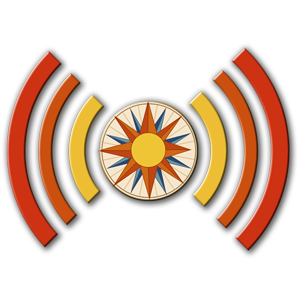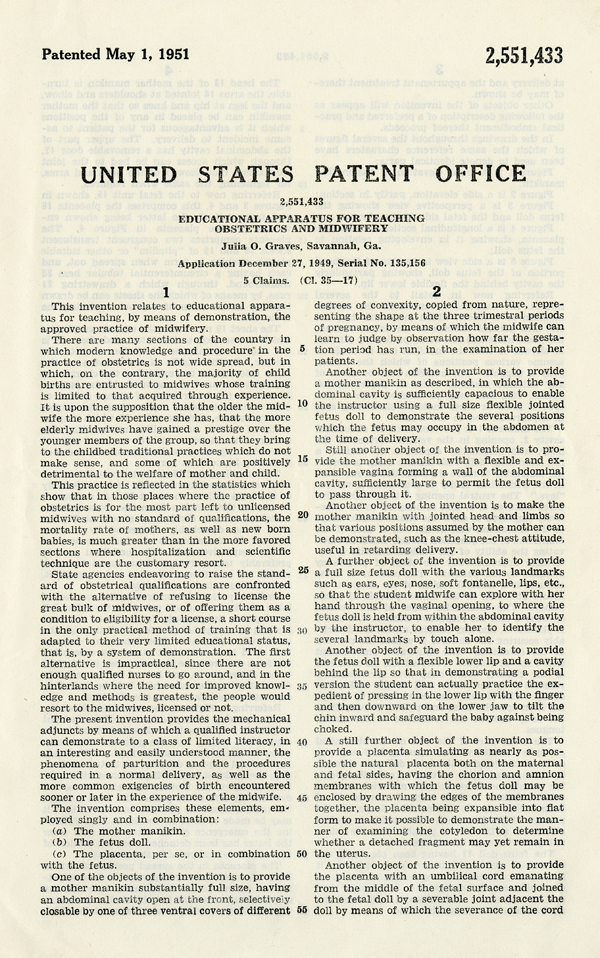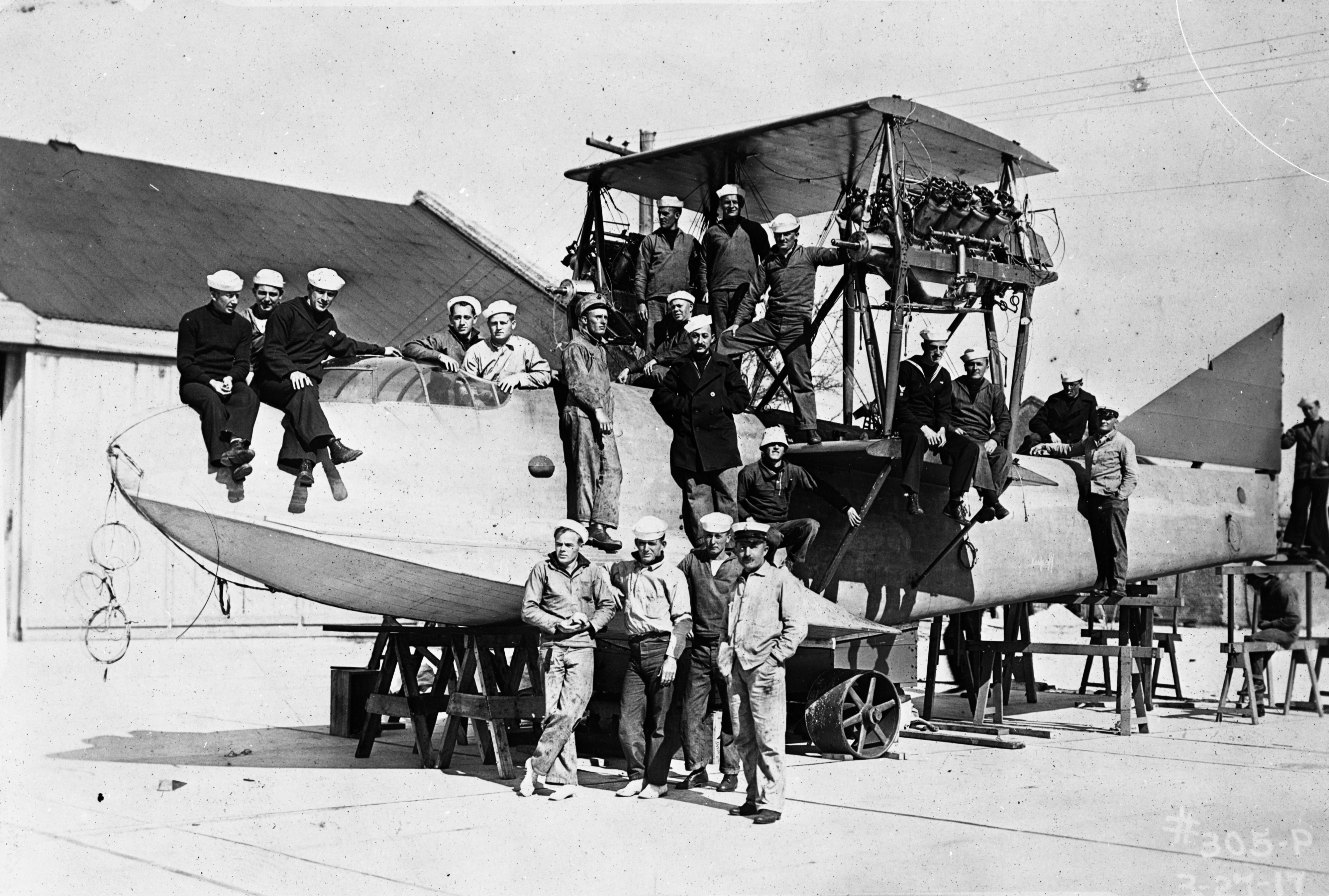Patent for Obstetrical Apparatus.
Date: May 1, 1951
Series: S 900 - Florida State Board of Health Subject files, 1875-1975.
Midwifery.
(Page 1 of 3)
Transcript
[page 1]
Patented May 1, 1951 2,551,433
UNITED STATES PATENT OFFICE
2,551,433
EDUCATIONAL APPARATUS FOR TEACHING
OBSTETRICS AND MIDWIFERY
Julia Oleander Graves, Savannah, Ga.
Application December 27, 1949, Serial No. 135,156.
5 Claims. (Cl. 35 - 17)
1
[left column]
This invention relates to education appara-
tus for teaching, by means of demonstration, the
approved practice of midwifery.
There are many sections of the country in
which modern knowledge and procedure in the 5
practice of obstetrics is not wide spread, but in
which, on the contrary, the majority of child
births are entrusted to midwives whose training
is limited to that acquired through experience.
It is upon the supposition that the older the mid- 10
wife the more experience she has, that the more
elderly midwives have gained a prestige over the
younger members of the group, so that they bring
to the childbed traditional practices which do not
make sense, and some of which are positively 15
detrimental to the welfare of mother and child.
The practice is reflected in the statistics which
show that in those places where the practice of
obstetrics is for the most part left to unlicensed
midwives with no standard of qualifications, the 20
mortality rate of mothers, as well as new born
babies, is much greater than in the more favored
sections where hospitalization and scientific
technique are the customary resort.
State agencies endeavoring to raise the stand- 25
ard of obstetrical qualifications are confronted
with the alternative of refusing to license the
great bulk of midwives, or of offering them as a
condition to eligibility for a license, a short course 30
in the only practical method of training that is
adapted to their very limited educational status,
that is, by a system of demonstration. The first
alternative is impractical, since there are not
enough qualified nurses to go around, and in the 35
hinterlands where the need for improved knowl-
edge and methods is greatest, the people would
resort to the midwives, licensed or not.
The present invention provides the mechanical
adjuncts by means of which a qualified instructor
can demonstrate to a class of limited literacy, in 40
an interesting and easily understood manner, the
phenomena of parturition and the procedures
required in a normal delivery, as well as the
more common exigencies of birth encountered
sooner or later in the experience of the midwife. 45
The invention system comprises these elements, em
ployed singly and in combination:
(a) The mother manikin.
(b) The fetus doll.
(c) The placenta, per se, or in combination 50
with the fetus.
One of the objects of the invention is to provide
a mother manikin substantially full size, having
an abdominal cavity open at the front, selectively
closable by one of three ventral covers of different 55
[right column]
2
degrees of convexity, copied from nature, repre-
senting the shape at the three trimestral periods
of pregnancy, by means of which the midwife can
learn to judge by observation how far the gesta
tion period has run, in the examination of her
patients.
Another object of the invention is to provide
a mother manikin as described, in which the ab-
dominal cavity is sufficiently capacious to enable
the instructor using a full size flexible jointed
fetus doll to demonstrate the several positions
which the fetus may occupy in the abdomen at
the time of delivery.
Still another object of the invention is to pro-
vide the mother manikin with a flexible and ex-
pansible vagina forming a wall of the abdominal
cavity, sufficiently large to permit the fetus doll
to pass through it.
Another object of the invention is to make the
mother manikin with jointed head and limbs so
that various positions assumed by the mother can
be demonstrated, such as the knee-chest attitude,
useful in retarding delivery.
A further object of the invention is to provide
a full size fetus doll with the various landmarks
such as ears, eyes, nose, soft fontanelle, lips, etc.,
so that the student midwife can explore with her
hand through the vaginal opening, to where the
fetus doll is held from within the abdominal cavity
by the instructor, to enable her to identify the
several landmarks by touch alone.
Another object of the invention is to provide
the fetus doll with a flexible lower lip and a cavity
behind the lip so that in demonstrating a podial
version the student can actually practice the ex-
pediment of pressing in the lower lip with the finger
and then downward on the lower jaw to tilt the
chin inward and safeguard the baby against being
choked.
A still further object of the invention is to
provide a placenta simulating as nearly as pos-
sible the natural placenta both on the maternal
and fetal sides, having the chorion and amnion
membranes with which the fetus doll may be
enclosed by drawing the edges of the membranes
together, the placenta being expansible into flat
form to make it possible to demonstrate the man-
ner of examining the cotyledon to determine
whether a detached fragment may yet remain in
the uterus.
Another object of the invention is to provide
the placenta with an umbilical cord emanating
from the middle of the fetal surface and joined
to the fetal doll by a severable joint adjacent the
doll by means of which the severance of the cord

 Listen: The World Program
Listen: The World Program
